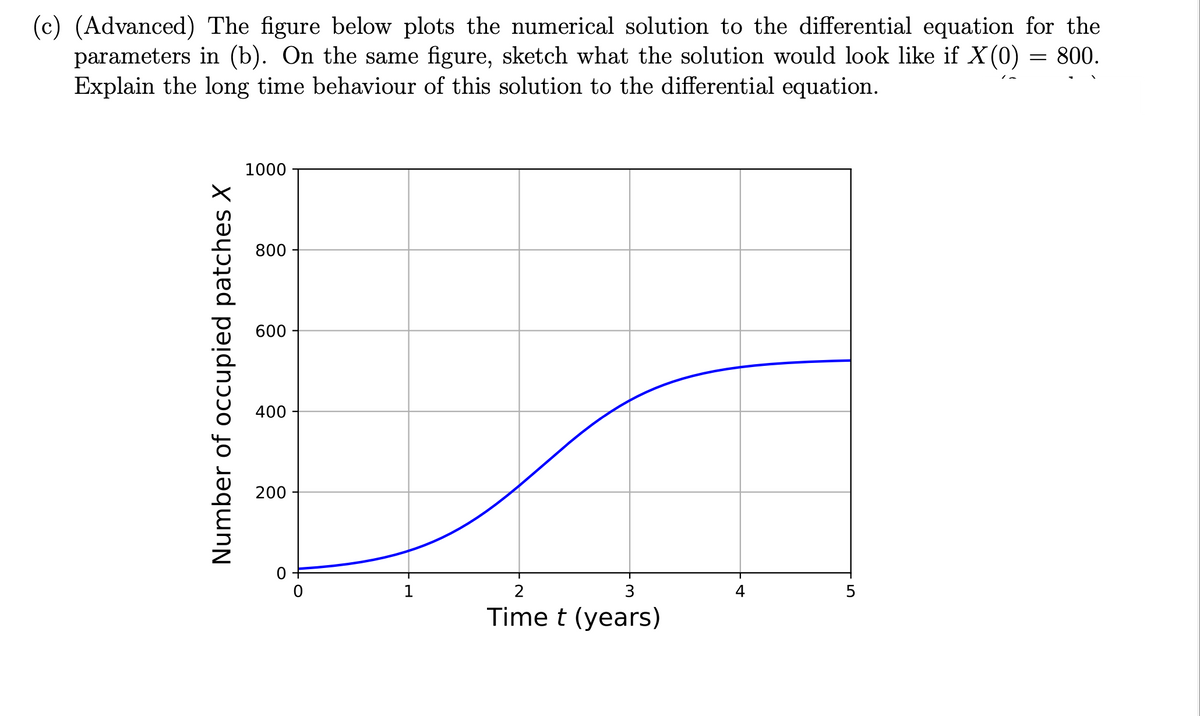Imagine a large number of habitat patches, N, of which X(t) are occupied at time t. The remainder, N - X(t), are empty and available for colonization by individuals dispersing from the occupied patches. Imagine that each occupied patch produces potential colonizers at the rate c. These propagules settle, randomly, on any patch; a fraction (N-X)/N land on empty patches that they colonize. The total colonization rate is then cX(N-X)/N. The differential equation for the number of occupied patches is N X X' = CX x (^~^) - ₁ (² - dX. N (a) Explain the effect of the term -dX, assuming that d is positive. Give a plausible physical inter- pretation of the constant d.
Imagine a large number of habitat patches, N, of which X(t) are occupied at time t. The remainder, N - X(t), are empty and available for colonization by individuals dispersing from the occupied patches. Imagine that each occupied patch produces potential colonizers at the rate c. These propagules settle, randomly, on any patch; a fraction (N-X)/N land on empty patches that they colonize. The total colonization rate is then cX(N-X)/N. The differential equation for the number of occupied patches is N X X' = CX x (^~^) - ₁ (² - dX. N (a) Explain the effect of the term -dX, assuming that d is positive. Give a plausible physical inter- pretation of the constant d.
Advanced Engineering Mathematics
10th Edition
ISBN:9780470458365
Author:Erwin Kreyszig
Publisher:Erwin Kreyszig
Chapter2: Second-order Linear Odes
Section: Chapter Questions
Problem 1RQ
Related questions
Question
here is the b question:
Find the value of X after one year using Euler’s method to solve the differential equation for the following parameters: c = 3.4 year−1, d = 1.6 year−1, N = 1000, and X(0) = 10, using a time step of h = 0.5 years.
However, do question C only

Transcribed Image Text:= 800.
(c) (Advanced) The figure below plots the numerical solution to the differential equation for the
parameters in (b). On the same figure, sketch what the solution would look like if X(0)
Explain the long time behaviour of this solution to the differential equation.
1000
800
600
400
2
3
4
Time t (years)
Number of occupied patches X
200
1
LO
5
![A paper by Mullineaux et al. [3] discusses models for meta-populations in the region around deep sea
hydrothermal vents. These create a “patchwork" of sea floor habitats that host their own ecosystems.
Quoting from Ref. [3]:
Imagine a large number of habitat patches, N, of which X(t) are occupied at time t. The
remainder, N- X(t), are empty and available for colonization by individuals dispersing
from the occupied patches. Imagine that each occupied patch produces potential colonizers
at the rate c. These propagules settle, randomly, on any patch; a fraction (N-X)/N land
on empty patches that they colonize. The total colonization rate is then cX(N − X)/N.
The differential equation for the number of occupied patches is
N X
X' = cX
ex (~ ~ *) -
- dX.
N
(a) Explain the effect of the term −dX, assuming that d is positive. Give a plausible physical inter-
pretation of the constant d.](/v2/_next/image?url=https%3A%2F%2Fcontent.bartleby.com%2Fqna-images%2Fquestion%2Ff76347ea-2b7c-4a9a-ac33-e39a62feec13%2F614c8a4f-9a79-4db8-9b95-995af1cd57c5%2F37kz2wu_processed.png&w=3840&q=75)
Transcribed Image Text:A paper by Mullineaux et al. [3] discusses models for meta-populations in the region around deep sea
hydrothermal vents. These create a “patchwork" of sea floor habitats that host their own ecosystems.
Quoting from Ref. [3]:
Imagine a large number of habitat patches, N, of which X(t) are occupied at time t. The
remainder, N- X(t), are empty and available for colonization by individuals dispersing
from the occupied patches. Imagine that each occupied patch produces potential colonizers
at the rate c. These propagules settle, randomly, on any patch; a fraction (N-X)/N land
on empty patches that they colonize. The total colonization rate is then cX(N − X)/N.
The differential equation for the number of occupied patches is
N X
X' = cX
ex (~ ~ *) -
- dX.
N
(a) Explain the effect of the term −dX, assuming that d is positive. Give a plausible physical inter-
pretation of the constant d.
Expert Solution
This question has been solved!
Explore an expertly crafted, step-by-step solution for a thorough understanding of key concepts.
Step by step
Solved in 3 steps with 2 images

Recommended textbooks for you

Advanced Engineering Mathematics
Advanced Math
ISBN:
9780470458365
Author:
Erwin Kreyszig
Publisher:
Wiley, John & Sons, Incorporated

Numerical Methods for Engineers
Advanced Math
ISBN:
9780073397924
Author:
Steven C. Chapra Dr., Raymond P. Canale
Publisher:
McGraw-Hill Education

Introductory Mathematics for Engineering Applicat…
Advanced Math
ISBN:
9781118141809
Author:
Nathan Klingbeil
Publisher:
WILEY

Advanced Engineering Mathematics
Advanced Math
ISBN:
9780470458365
Author:
Erwin Kreyszig
Publisher:
Wiley, John & Sons, Incorporated

Numerical Methods for Engineers
Advanced Math
ISBN:
9780073397924
Author:
Steven C. Chapra Dr., Raymond P. Canale
Publisher:
McGraw-Hill Education

Introductory Mathematics for Engineering Applicat…
Advanced Math
ISBN:
9781118141809
Author:
Nathan Klingbeil
Publisher:
WILEY

Mathematics For Machine Technology
Advanced Math
ISBN:
9781337798310
Author:
Peterson, John.
Publisher:
Cengage Learning,

